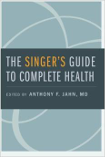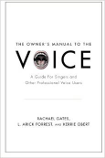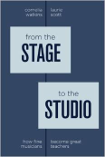

 Cornelia Watkins and Laurie Scott, From the Stage to the Studio: How Fine Musicians Become Great Teachers (New York: Oxford University Press. 2012), ff. xv, pp. 304; ISBN 978-0-19-974051-2.
Cornelia Watkins and Laurie Scott, From the Stage to the Studio: How Fine Musicians Become Great Teachers (New York: Oxford University Press. 2012), ff. xv, pp. 304; ISBN 978-0-19-974051-2.
Anthony F. Jahn, M.D., editor, The Singer’s Guide to Complete Health (New York: Oxford University Press, 2013), ff. xiv, pp. 470; ISBN 978-0-19537403-2.
Rachel Gates, L. Arrick Forrest, and Kerrie Obert, The Owner’s Manual to the Voice: A Guide for Singers and Other Professional Voice Users (New York: Oxford University Press, 2013), ff. xxi, pp. 262, access to compendium website; ISBN 978-0-19-996468-0.
Everything one knows is an asset; that which one does not know may be a liability. Such is the prevailing wisdom of these volumes––each in their own respect.
If a traveled singer were to possess any concise book––or indeed, carry a volume in their suitcase––pertaining to the health and well-being of the voice, it should be Anthony F. Jahn’s The Singer’s Guide to Complete Health. Jahn has enjoyed a thirty-year relationship with the Metropolitan Opera serving as Medical Director and as covering physician for the company’s singers.
Jahn writes seven of the thirty-six chapters; the remaining contributions are authored or co-authored by thirty-three contributors, nearly all of whom possess medical credentials. Certainly the accredited qualifications of the authors seek to underscore the reliable substance, content, and the overall value to singer and pedagogue alike. Edited in such a way as to be readable with both immediacy and clarity in its delivery, the compendium nevertheless tackles a wide variety of important issues. An invaluable contribution that may well be one of the first chapters a singer will read is the brief “Medications and the Voice” (Youngnan Jenny Cho), which may at least serve as a springboard into further study. Chapters range from the anatomy and physiological function of the singing voice and related body systems to primers on “Pulmonary Medicine for Singers” (Len Horovitz) and “Disorders of the Nose, Sinuses, and Throat: An Overview for Singers” (Jahn). A pair of chapters on auditory concerns supplement pragmatic chapters on “Hormones and the Voice” (Jean Abitbol), “Pregnancy: A Primer for Singers” (Jahn), and “Nutrition and Weight Management” (Sharon Zarabi). Moreover, issues that vex many performing artists are covered in chapters such as “Sleep: The Art and Science” (Rebecca J. Scott) and “Allergy Basics” (Boyan Hadjiev). The realities of the increasingly appearance-based performance field are explored in “Skin Care for the Performing Artist” (Karen H. Kim and Phillip C. Song), “Minimally Invasive Cosmetic Techniques” (Andrew Blitzer), and “Facial Plastic Surgery” (Maurice M. Khosh).
Just as significantly, Jahn augments the balance of the book between established medical practices with similarly appealing holistic options that one may elect to embrace into their lives. These chapters vary from “Meditation and Relaxation Techniques” (Steven K. H. Aung) and are intended for artists who endure perpetual scrutiny (externally and individually), alongside “Yoga for Singers” (Judith E. Carman), a complementary chapter. Health and fitness regimens are suggested in “Exercise Programs for Vocal Artists: An Effective Performance Enhancing Strategy” (Annette Osher and Richard A. Stein), and “The Alexander Technique for Singers” (Pedro de Alcantara) is equally beneficial for its focus on body alignment and awareness. Likewise, “Chinese Herbal Remedies for Singers” (Gertrude Kerbiena) and “Home Remedies” (Jahn) provide rudimentary insight into available treatments and perceived standbys. Other entries cover bariatric surgery from the perspectives of the medical practitioner and in a firsthand account from a singer who had the procedure. Additional chapters cover topics on musical theater (offered in views from London and New York), career longevity, and “Self-Screening for Vocal Injuries” (Anat Keidar and Nancy Kleeman Menges).
While the volume is not divided into sections––an aspect of convenience that may have been considered for ease of navigation in the Table of Contents––the brief chapter titles provide the reader with specifically germane information as to their material. None of the essays exceed twenty-four pages, while the median chapter length is circa twelve pages. A caveat to this otherwise indispensible volume is that it cannot hope to be complete. Nonetheless, it offers keen insights into managing––and living with––the miscellaneous issues relevant to the life of a singing artist. Yet comprehensiveness is clearly not Jahn’s intent, rather his edited volume distills both introductory and advanced information to an audience who may then delve into further study as it suits their individual needs. Active performers, teachers of voice, and choral music educators should have this volume on their desks or in their carry-on––not on their bookshelves––as a resource that will aid them in better understanding the flesh and blood instruments with which they are working.
In From the Stage to the Studio: How Fine Musicians Become Great Teachers, Cornelia Watkins and Laurie Scott balk at the misnomer that “those who can’t, teach,” instead opting for the now prevailing wisdom that many of the best studios are led by teachers whose careers were possessed by fine artistry and abilities onstage. In fact, the authors dispel the notion from their introductory sentence: “The fact is, you will teach, unless you vigorously resist invitations!”
Watkins and Scott divide this important book into three parts: “The Performing Musician,” “The Art of Teaching,” and “The Musician as a Teaching Professional.” The latter two chapters contribute fresh insight to such publications as The Strad and Strings, and perhaps the richest addition to the growing secondary literature that may currently exist largely in articles in The Journal of Singing and less so, Classical Singer. Frequently, however, such articles take a defensive posture of teacher vs. performer, one seeking to validate the other, or at least intimating that the veracity of the performer should not invalidate the efficacy of the teacher. Watkins and Scott do not fall into this trap. Moreover, the twelve appendices to the volume comprise a valuable asset to academician and independent applied professional alike.
From the Stage to the Studio emerges from two leaders in the nationally successful String Project, Watkins a cellist and Scott a violinist. The String Project could serve as a model for many instrumental and vocal teaching environments, as indeed From the Stage to the Studio may be applied across the musical disciplines. One may need to parse portions of the language, which is appropriately string-centric, but the authors not only acknowledge this in the body of the text, they also grant that other teaching professionals may adapt their concepts accordingly as appropriate to the relevant subdiscipline. A prevailing question that Watkins and Scott probe is if “schools, in order to offer music pedagogy, must provide a separate course for each performance area.” The reality of the twenty-first century academy is that, as lifelong learners, our young student-artists can gain considerable knowledge about pedagogy across the subdisciplines of our field.
Watkins and Scott did not attempt to dilute the contents of their writing in an overly generalized manner, which is to their credit. The result is that they call upon the reader to engage more richly with the text, applying pedagogical principles as relevant. The optimal outcome for the reader can only be assimilation into a studio-specific standard that will produce advantageous results. [Careful copy-editing would have ensured that unnecessary typographical errors would have been avoided (e.g. “Nusicians” on p. 284).]
Rachel Gates, L. Arrick Forrest, and Kerrie Obert certainly provide a beneficial physiological introduction to The Owner’s Manual to the Voice: A Guide for Singers and Other Professional Voice Users, detailing the anatomy and function of the singing apparatus. Throughout the volume words in boldface prompt the reader to the thirty-two-page glossary of terms, medical codes, and abbreviations related to the care and treatment of the voice found in the fifteenth and final chapter of the book. However, lacking within its contents is anything exceeding a more than perfunctory examination of the voice and its care. Regrettably, the authors do not contribute anything new to the existing secondary literature surrounding the health and wellbeing of the voice; nothing that in any way rises to the level of the previously published and valued contributions of Barbara Doscher’s The Functional Unity of the Singing Voice or any of Richard Miller’s voluminous output. The authors’ consistent use of text boxes throughout The Owner’s Manual to the Voice has, perhaps, the opposite effect than was intended: pages frequently look cluttered and the abundant text boxes distract––reminding one more of a series of previously used PowerPoint slides from conference papers or classroom lectures than those of a textbook. Five slim bibliographic pages comprised of books, articles, and websites, may provide just the right amount of reading for an introductory course, thus one should not be quick to dismiss The Owner’s Manual to the Voice, for it may find its greater relevance in the classroom (and primarily the undergraduate classroom at that). Nevertheless, it is a worthwhile volume for just that purpose.
If the pair of vocal offerings from Oxford University Press––Jahn’s The Singer’s Guide to Complete Health and Gates, Forrest, and Obert’s The Owner’s Manual to the Voice––was to be compared, there is a clear volume that rises to the top. Jahn’s volume is for professional artists and teachers, while the Gates, et al., text will be most useful to the undergraduate voice student. While the latter may indeed be a useful classroom text, Jahn’s Guide offers a comprehensive element that cannot be matched by any such volume of its length. The immensely valuable contribution to the study of pedagogy––as the authors convey, in any classroom setting––is Cornelia Watkins and Laurie Scott’s From the Stage to the Studio. Watkins and Scott challenge academic and student alike to break subdisciplinary barriers between applied studios within the conservatoire and embrace concepts that every pedagogue, artist, and student faces. Watkins and Scott have contributed the architecture for the beginning of what should be an evolving conversation––the beginning of discursive engagement across applied studios––that will benefit all those who engage in the art and artistry of performance and pedagogy.
